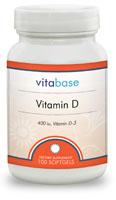| Animal products constitute the bulk source of vitamin D that occurs naturally in unfortified foods. Salt water fish such as herring, salmon, sardines, and fish liver oils are good sources of vitamin D3. Small quantities of vitamin D3 are also found in eggs, veal,
beef, butter, and vegetable oils while plants, fruits, and nuts are extremely poor sources of vitamin D. Two forms of vitamin D, cholecalciferol and ergocalciferol, are naturally found in foods and are added to milk. It is important to note that the milk used to make yogurt and cheese is usually not vitamin D fortified. Cholecalciferol, is manufactured by the skin when it is exposed to the ultraviolet (UV) rays of the sun.
Sun exposure is perhaps the most important source of vitamin D because exposure to sunlight provides most humans with their vitamin D requirement. 10 to 15 minutes every day of sun exposure on the face and the hand is sufficient. The vitamin we store during the summer lasts us during the winter. Clouds, smog, clothing, sunscreen, and window glass all decrease the amount of sunlight that actually reaches the skin.
The food sources of vitamin D are somewhat limited but include fatty fish, such as salmon and sardines, egg yolks and fortified cereals. Fortified foods are the major dietary sources of vitamin D. The best dietary source for vitamin D is milk, which is fortified with enough to provide 100 IUs in just a cup. Yogurt and cheese are not good sources since they are not made with fortified milk. One cup of vitamin D fortified milk supplies about one-fourth of the estimated daily need for this vitamin for adults. Although milk is fortified with vitamin D, dairy products made from milk such as cheese, yogurt, and ice cream are generally not fortified with vitamin D. | 